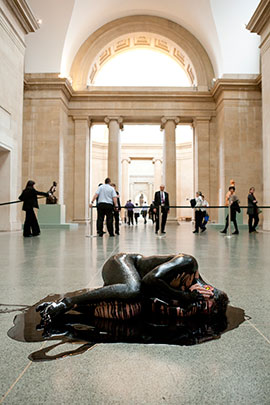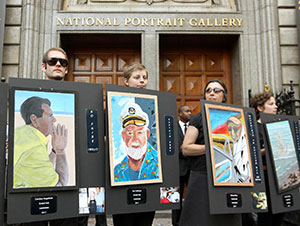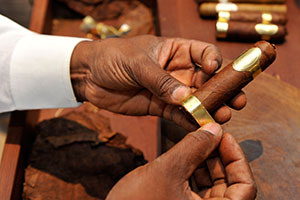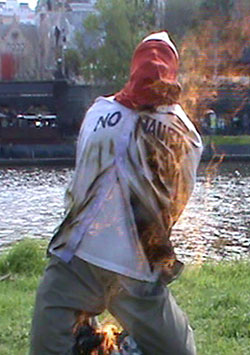Who funds the arts and why we should care
Simply sign up to the Life & Arts myFT Digest -- delivered directly to your inbox.
Anyone passing through Tate Modern’s Turbine Hall one recent Saturday might have witnessed an unscheduled performance by a group of people writhing beneath a huge square of black cloth. Taking its motif from the Malevich exhibition at Tate, the event – entitled “Hidden Figures” – was designed to flag up the museum’s refusal to reveal details of its financial relationship with BP. It was the latest in a series of protests about the sponsorship of institutions – among them the British Museum and the National Portrait Gallery – by the energy giant responsible for the Deepwater Horizon disaster of 2010.
The protesters have been undeterred by the fact that the institutions have acted perfectly within the law, or that BP has been a generous and longstanding sponsor of the arts. Rather, such events are the tip of an iceberg of anger currently focused on a wide range of sponsorship, which in recent years has become an essential part of the infrastructure of the art world. In the past few weeks alone, the São Paulo Biennial dropped the logo of the Israeli Embassy after artists and curators complained. A week earlier, the Gwangju Bienniale’s president resigned and various artists withdrew after its financial backer, the city’s government, censored a work.
Both Manifesta in Russia and the Sydney Biennale have been hit by boycotts. Frieze Art Fair in New York ran into trouble for using non-unionised labour, and the organisation has now agreed to employ only unionised workers next year. Meanwhile, the labour conditions on Abu Dhabi’s Saadiyat Island, which provoked an artists’ threatened boycott of museums being built there, including the Guggenheim and the Louvre, are still unresolved.

Governments, too, are stepping into the debate. Last month, Art Basel heard that a change in Swiss law might mean that it loses its sponsorship from cigar manufacturer Davidoff. (In the UK, tobacco companies are allowed to sponsor cultural and sporting events only if they use their company name rather than a brand of cigarettes.)
Art and patronage are ancient bedfellows and bursts of outrage are nothing new. But the sheer weight of discontent suggests we are reaching a tipping point. When the curators of the São Paulo Biennial wrote to the organisers in support of the artists’ objections, they declared that the Brazilian situation “should also be a trigger to think about funding sources of major cultural events”. In their opinion, “the sources of cultural funding have an increasingly dramatic impact on the supposedly ‘independent’ curatorial and artistic narrative of an event”.
The thrust of this argument is that art is compromised if the finance is unethical. “In the 31st biennial, much of the work seeks to show that struggles for justice in Brazil, Latin America and elsewhere in the world are connected,” the São Paulo curators continue. In other words, work will lose its integrity if it depends on support from those seen to be perpetuating problems.
The tensions extend beyond geopolitics. “Creativity has become …instrumentalised both by capitalism and the nation state,” says São Paulo curator Charles Esche. In some countries, once-generous state subsidies have been swept away. In others, they never existed. Whatever the history, art’s paymasters will always have their own agenda. “During the cold war, institutions were representing that conflict in their programming,” says Esche of a period when state funding was far more beneficent in northern Europe.

Now, the growing dependence on private funding is igniting new concerns. “The corporate ethos has permeated deeply into museum culture,” says Professor Julian Stallabrass of the Courtauld Institute of Art, who has written extensively on the pact between commerce and culture. “The brand permeates everything, from the products in the shop to the designer uniform of the staff.”
Like the São Paulo curators, Stallabrass points out that the tension between content and context creates a paradox. “Much avant-garde and contemporary art is actively hostile towards capitalism. If an artist who is critiquing corporate power is presented as part of this branded apparatus, the work is being betrayed quite fundamentally.” Equally, when an institution or an event is being sustained through, say, exploitative labour practices, certain artists are going to question the ethics of their own participation there.
Curators are questioning whether dependence on private benefactors exacts too high a price. Emily Pethick, of the Showroom, a London-based, not-for-profit space that specialises in emerging and experimental artists, says: “Previously, when I was working in the Netherlands where we had a much higher subsidy, we could speculate and take more risks.”

The Showroom, in partnership with two other non-profit spaces, Studio Voltaire and Chisenhale Gallery, was recently the beneficiary of a £210,000 grant from Arts Council England that is only awarded on the basis that the recipient can match these funds with private donations. She finds, however, that it is a struggle to persuade private givers, in particular corporate investors, trusts and foundations, to buy into ideas that are still at the speculative stage. “That’s what happens with the attrition of public funds,” says Pethick.
Elsewhere, the shift in mood is equally tangible. Julia Friedrich, a curator at the Ludwig Museum in Cologne, says there is now far more pressure to find private sponsorship for shows than there was even 10 years ago. She believes that a loss of independence is inevitable when private money is involved. “Sponsors want exhibits that are popular. I am not saying that popular artists are bad artists but the choice is not as independent as it is when the money is there already. Most sponsors think very carefully about what they want to connect their names and logos to.”
The institutions say they have no choice but to buy into the slick new world. “It’s a very competitive market for all art institutions,” says Jennifer Suggitt, head of corporate relations at the British Museum, which for 2013-14 received a government grant of £43.9m (£1.5m less than the previous year) and raised more than double that sum from a mix of donations, legacies, and commercial and charitable activities.

“We have to be pragmatic about the fact that the only way we can put on temporary exhibitions of the world-class standard we aspire to is if we have external funding. And the levels of funding that we look for are possible only through the corporate world.”
Some of the most active cultural sponsors are investment banks. The British Museum, for example, lists Morgan Stanley, Goldman Sachs and Bank of America Merrill Lynch among its corporate partners. Asked whether or not there was a contradiction in a public cultural institution taking money from companies that are simultaneously under fire for damaging the fabric of society, Suggitt replied: “It’s not for the British Museum to judge how organisations operate.” She is fearful that “so much criticism [of those] supporting the arts could really affect how much arts organisations are funded in future”.
Yet if an institution’s financial relationships are irreproachable, why is there so little transparency? I could find no one at Art Basel prepared to answer a question about why it felt it acceptable to take tobacco sponsorship. Instead, Art Basel issued a statement that simply applauded Davidoff as a “dedicated supporter of art”. Both Tate Modern and the British Museum declined to give me any financial details about their collaborations with BP, stating that the link was in line with their ethics policies.
The refusal to be more communicative can put public institutions on shaky ground. In April this year, the UK Information Commissioner ruled that Tate should remove redactions from committee minutes that discussed details of the BP sponsorship. Tate has appealed against that ruling and is awaiting a judgment.
If the art world finds itself with more moral watchdogs snapping at its heels than ever before, it is partly as a result of its unprecedented growth. Every year, we see more biennials, new museums, the expansion of older museums and glossier shows, all of which must be funded. Simultaneously, more artists are making works with a political and social resonance. “Culture is much more politicised,” says Esche. “The changes in funding are going in hand in hand with changes in the kind of role that artists are demanding.”
A new commitment to openness will not neutralise the situation but it may defuse it a little. “Transparency is essential,” observes Esche. “So far it’s happening as a struggle rather than a protocol. It needs to become a protocol.”
Photographs: Amy Scaife/Van Thanh Rudd
——————————————-
Letter in response to this article:
Art needs its non-market, public sector credibility / From James Goodwin, Ipswich, Suffolk, UK
Comments